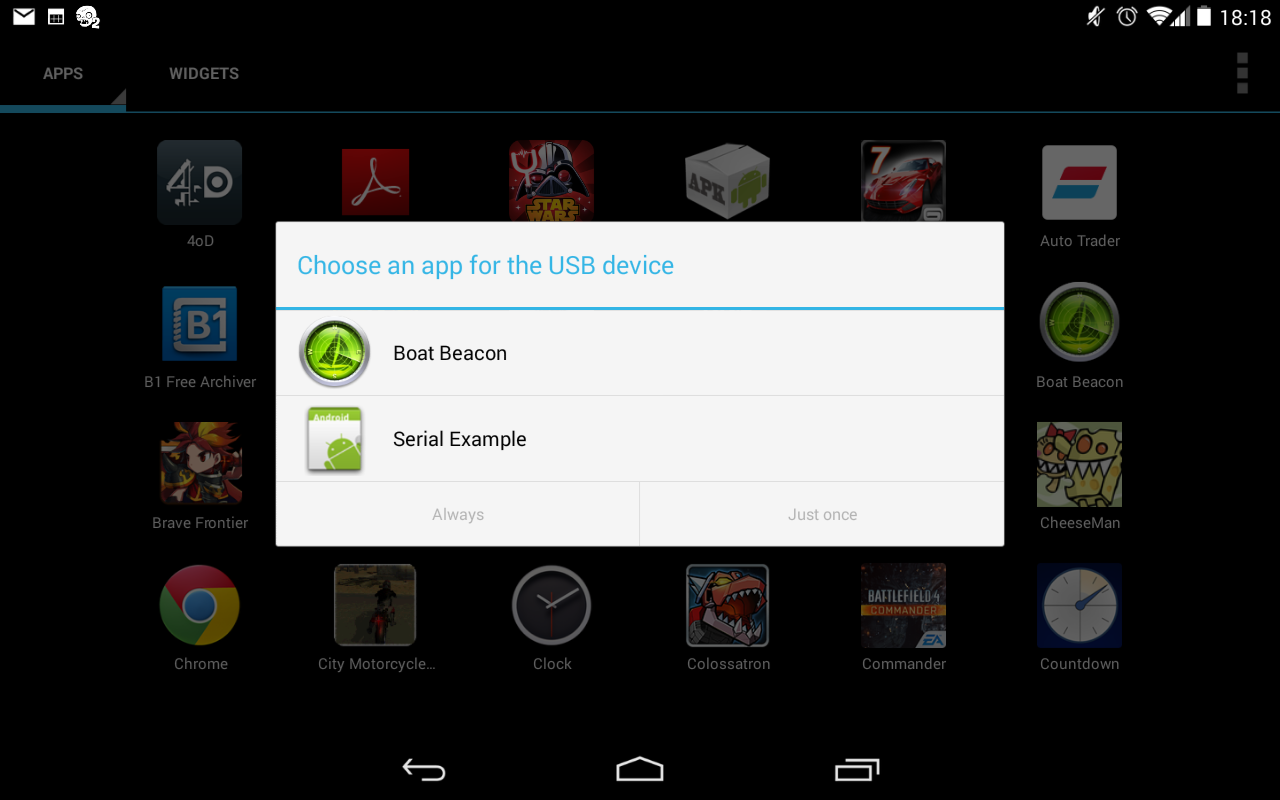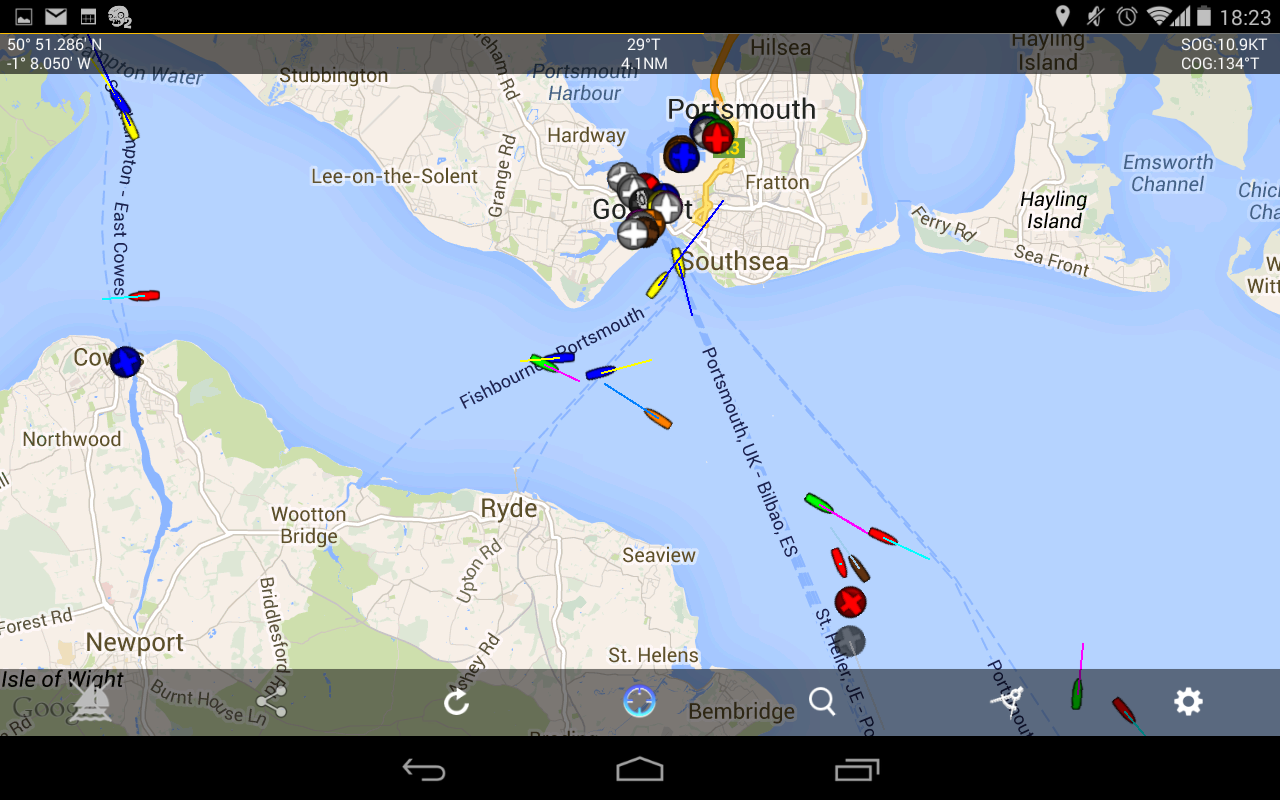Today we finished a series of successful tests, connecting our AIS receivers to a Google Nexus 7 Android tablet. This has been made possible by a new version of Boat Beacon. The popular AIS App for Apple and Android devices, which should soon be available (as a free update) on the Apple Store and Google Play Store. Therefore allowing connection of an AIS receiver to an Android tablet.
One of the most popular features of Boat Beacon is that is allows you to receive AIS data on your phone or tablet (from the internet) without having to install an AIS receiver on your boat. What is more, you could also transmit your position (without having an AIS transponder). As a result allowing you to appear on AIS websites like Marine Traffic, Ship Finder and AIS Hub. Therefore friends and family can track your passage. In order to receive AIS data and transmit your position, you needed to have a 3G internet connection, but for many people Boat Beacon was a great app to have and introduced them to the world of AIS.
Relying solely on Internet AIS data does have serious limitations though, namely;
- Holes in the AIS network coverage
- Slow update speeds
- Constant risk of losing the 3G internet connection
This is the reason why most boat owners ultimately decide to fit an AIS receiver on their boat. However, you then have the issue of getting this AIS data on to your phone/tablet. With Apple devices, currently the only option is to use one of our Wireless NMEA units. Which will convert the AIS data in to wireless NMEA data that an App running on the iPhone/iPad can read. Many Apps including Boat Beacon support Wireless NMEA, which we documented in a recent article.
However, many Android devices now support USB “On the Go” (OTG) which allows you to plug in USB slave devices – see USB OTG cable in image above. In order for the USB slave device to work correctly, Android must have suitable drivers installed. There must also be an App running that knows how to use the USB device. As part of our testing, we confirmed that the drivers for all of our AIS receivers (and our NMEA to USB adaptor cable) are pre-installed in Android. It was also determined that the latest Boat Beacon App will read the NMEA0183 AIS data. You can then see the AIS targets on its chart display.
Installation could not be easier. You simply plug in the USB OTG cable to your Android device and then download the latest version of Boat Beacon. Finally plug the USB lead of one of our AIS Receivers in to the OTG cable. Android should detect the AIS device and ask you to confirm that you want Boat Beacon to use this device.
Boat Beacon will open and you will see live AIS data starting to come in and displayed on the Boat Beacon app.
The app features CPA and TCPA alarms and colour coded AIS targets. As well as the facility to also transmit your position back to the internet AIS sites via 3G. Therefore Boat Beacon is the best AIS App for Android. Furthermore, it now has the option of connecting our AIS receivers via USB. Or alternatively any of our AIS units via one of our Wireless NMEA adaptors (WLN10, NavLink, iNavHub, etc.). As a result you have an app that can be seriously used at sea as an AIS display and alarm system.
For more information on Boat Beacon visit the Play Store by clicking here.











Great post. I will be facing a few of these issues as well..
Hi,
I am thinking about buying the equipment required to run AIS on a Galaxy tab and I wonder if you could answer a couple of questions?
I think I am going to need a Galaxy tab (with USBOTG capability, and in-built GPS), a USBOTG cable, an AIS receiver and the Boat Beacon software.
My ideal AIS setup would work without internet or phone connection (only the Galaxy’s GPS). Is that possible?
I intend on using Navionics as my main chart program, sailing in SE Asia. Is there a way that an AIS receiver could work with Navionics, or would I be using a seperate screen (with Boat Beacon) to see AIS info?
This looks like quite a revolutionary development, so I’m hoping I can make it work for my boat.
Catherine
Hi Catherine,
Unfortunately the popular Navionics App cannot accept external wireless NMEA data, so although you will be able to see your position on the chart, you cannot also show AIS or instrument data on their App.
Boat Beacon is very good and can display “Live” AIS data on a Google Map from one or our AIS receivers such as the AIS100USB or uAIS connected to the Google USBOTG port – alternatively, you can use one of our wireless iAIS receivers and send the AIS data wirelessly if you want to lose the USB connection. Boat Beacon also transmits your position via 3G and so anyone looking at the AIS data on the web or via the Boat Beacon app can see where you are – useful for family and friends, but not a replacement for a real AIS transponder.
If you decide to go the wireless route, the other App I would look at is iRegatta and this can display AIS data on a “Radar” type display (no charts but range rings) and it can also receive Instrument Data (speed, depth, wind, etc.) over the same wireless connection – you would need to connect the NMEA0183 output of your instrument system to the input of our wireless iAIS receiver.
So there are a number of options to check out and if you have any more questions please come back to us.
Best regards
PAUL
Hi,
do I take it right:even with your own AIS receiver you still Need a 3G connection for the maps? Or can you use offline maps?
Best regards
Ollie
Hi Ollie, yes you will have to have a 3G connection in order to display the background map. The App will store (cache) any maps that it has previously downloaded whilst online but you will need to have zoomed in/out and panned around over the entire route of your trip to be sure that you have all of the maps cached for your voyage.
When will Boat Beacon that connects and AIS receiver to a Google Nexus 7 Android tablet be available? Thanks, Don
Hi Don,
Boat Beacon is available now or you might prefer our AISView App for Android which I use with my Nexus 7 and one of our AIS100 USB units https://play.google.com/store/apps/details?id=com.digitalyacht.navlink&hl=en_GB
Best Regards Paul
I have MX Mariner installed on my Nexus 7 tablet. I works well. Will Boat Beacon attached to an AIS receiver, such as your Digital Yacht AIS 100m use the MX Mariner installed maps?
Thanks, Don
Hi Don,
Unfortunately the apps in MX Mariner can only be accessed by their App and other apps cannot use them. The same is true for the Navionics App that comes with some really nice vector charts, but they cannot be accessed by other apps.
Best regards PAUL
Hi,
I’m running Memory Map Pro on a Windows laptop connected to an AIT2000 AIS transceiver via an FTDI cable on the brown and orange leads from the AIT2000. All is running well.
Recently I got a Nexus 7 (2012) tablet and installed the Memory Map app. If I want to display AIS info on the MM app do I connect the tablet to the AIT2000 with a USB/OTG cable (same as the laptop)?
Or does it need to be connected to the USB cable coming out of the transceiver?
Thanks.
Peter.
Hi Peter,
I would recommend using the FTDI cable as you have been doing on the Windows Laptop. The FTDI driver is part of the Android OS so this should be fine, but you might want to check with Memory Map to see if they have tested their App with USB/OTG. I remember that with our AISView App we had to add this feature when USB/OTG started to be supported by the tablets.
Hope this helps
PAUL
Thanks Paul …. no luck with Memory Map on my tablet, which was later confirmed by them. Not to be cheeky, but is your Android AISView App available for free download on your site, or is it only for sale on Google Play? Cheers, Peter
Hi Paul, I’ve decided it’s easier to have both memory Map and AISView running together so I can toggle between them as needed, so I’ve installed AISView on my Nexus 7, plugged in the OTG cable to the FTDI cable. However, I cannot see any AIS targets coming up on the tablet (no problem with the FTDI cable plugged into my laptop, so I know I’m receiving AIS data.) I’m running Android 5.0.2. My understanding is that no additional drivers are needed for the Android OS. Is some further setup needed on AISView or on the AIT2000? Any help would be much appreciated! Thanks, Peter.
Hi Peter, in the settings menu of AISView, there is a “Local AIS via USB” option that needs to be turned on and if there is data coming in on the USB then the indicator on this option will go green.
If you still cannot get it working, please raise a support ticket on our website as this will be a more efficient method to sort this out rather than on this blog.
Thanks … that did the trick! Peter.
Hallo,
Is it possible to connekt UAIS reciever with android tablet??
Hi,
Yes it is and we have a few customers that are using our AIS receivers and USB to NMEA adaptors with Android tablets/phones with good results, BUT there have been a couple of customers that did not manage to get this working and there seem to be differences between some devices, for instance the Galaxy Tab 2 did not work.
Please have a look at this article for more information…
http://android.stackexchange.com/questions/36887/how-can-i-determine-if-my-device-has-usb-host-mode-otg-support
Hi
You write: Yes it is and we have a few customers that are using our AIS receivers and USB to NMEA adaptors with Android tablets/phones with good results.
I’m using Seanexx200 + Nexus10 Tablet, Ver.1 with stock Android 5.1.1, Ver.2 rooted, Ver. 3 Cyanogenmod12.1
This is not runnig, I think no kernel-driver.
Do have examples of tablets which can connect via USB ?
Hi Ernst,
Sorry for the delay in reply. What is Seanexx200 ? Is this a marine App ?
Which of our products have you connected to the Nexus10 ?
If you can provide a bit more info, I will try and help.
Best regards
PAUL